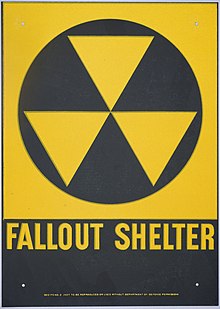
Back ملجأ ضد النووي Arabic Sığınacaq Azerbaijani Сховішча (ахоўнае збудаванне) Byelorussian Refugi antiatòmic Catalan Protiatomový kryt Czech Schutzraum German Refugio nuclear Spanish Babesleku nuklear Basque Abri antiatomique French מקלט גרעיני HE


| Nuclear weapons |
|---|
 |
| Background |
| Nuclear-armed states |
|
A fallout shelter is an enclosed space specially designated to protect occupants from radioactive debris or fallout resulting from a nuclear explosion. Many such shelters were constructed as civil defense measures during the Cold War.
During a nuclear explosion, matter vaporized in the resulting fireball is exposed to neutrons from the explosion, absorbs them, and becomes radioactive. When this material condenses in the rain, it forms dust and light sandy materials that resemble ground pumice. The fallout emits alpha and beta particles, as well as gamma rays.
Much of this highly radioactive material falls to Earth, subjecting anything within the line of sight to radiation, becoming a significant hazard. A fallout shelter is designed to allow its occupants to minimize exposure to harmful fallout until radioactivity has decayed to a safer level, over a few weeks or months.